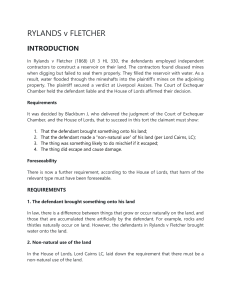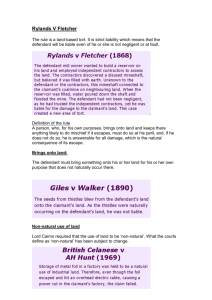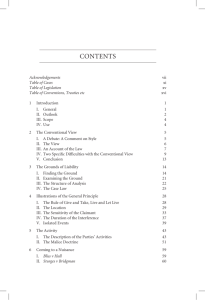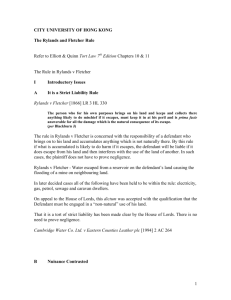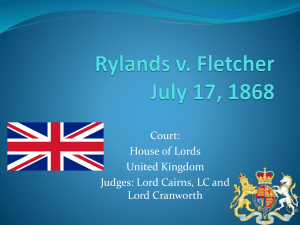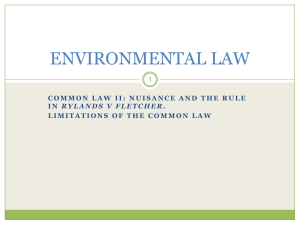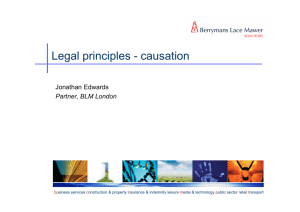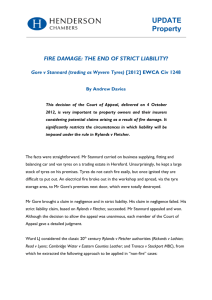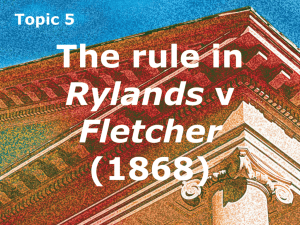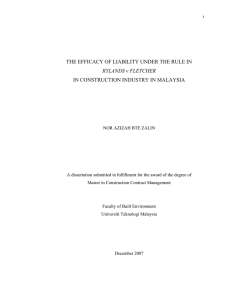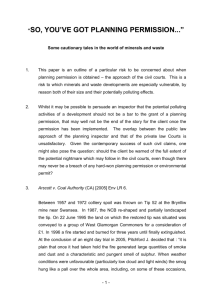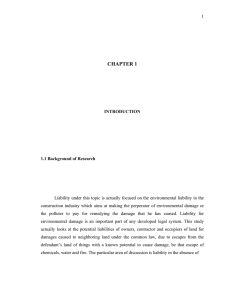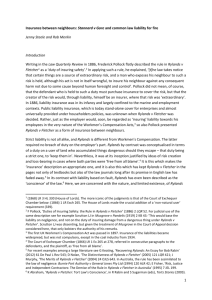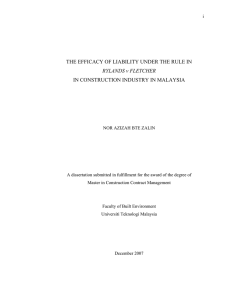RYLANDS v FLETCHER
advertisement
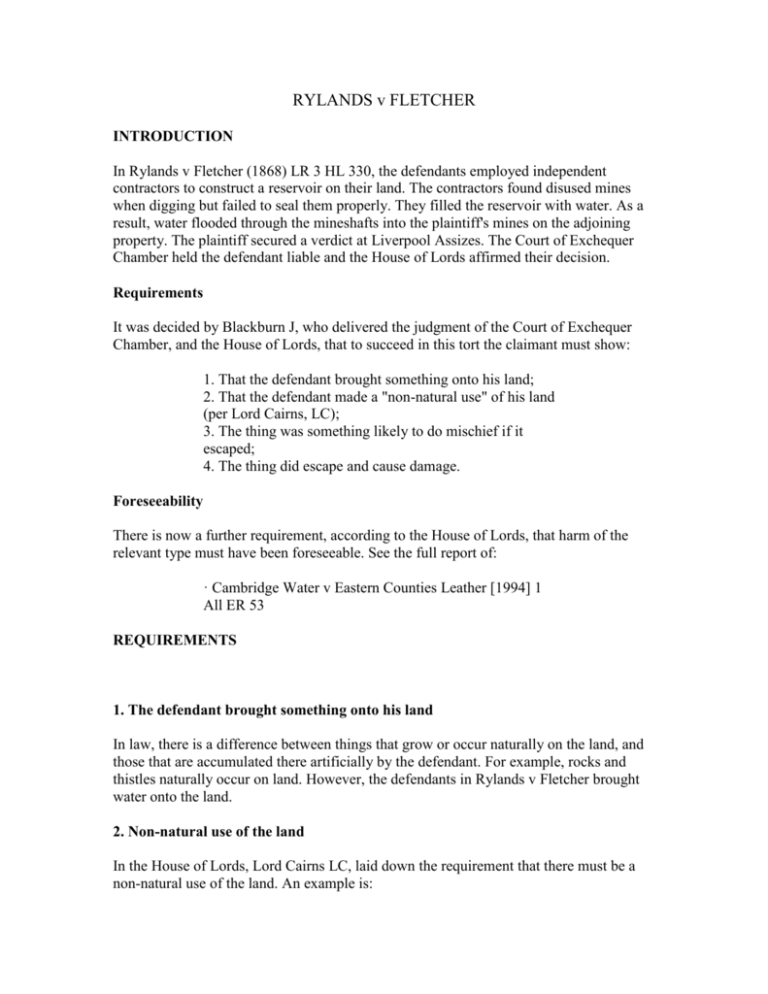
RYLANDS v FLETCHER INTRODUCTION In Rylands v Fletcher (1868) LR 3 HL 330, the defendants employed independent contractors to construct a reservoir on their land. The contractors found disused mines when digging but failed to seal them properly. They filled the reservoir with water. As a result, water flooded through the mineshafts into the plaintiff's mines on the adjoining property. The plaintiff secured a verdict at Liverpool Assizes. The Court of Exchequer Chamber held the defendant liable and the House of Lords affirmed their decision. Requirements It was decided by Blackburn J, who delivered the judgment of the Court of Exchequer Chamber, and the House of Lords, that to succeed in this tort the claimant must show: 1. That the defendant brought something onto his land; 2. That the defendant made a "non-natural use" of his land (per Lord Cairns, LC); 3. The thing was something likely to do mischief if it escaped; 4. The thing did escape and cause damage. Foreseeability There is now a further requirement, according to the House of Lords, that harm of the relevant type must have been foreseeable. See the full report of: · Cambridge Water v Eastern Counties Leather [1994] 1 All ER 53 REQUIREMENTS 1. The defendant brought something onto his land In law, there is a difference between things that grow or occur naturally on the land, and those that are accumulated there artificially by the defendant. For example, rocks and thistles naturally occur on land. However, the defendants in Rylands v Fletcher brought water onto the land. 2. Non-natural use of the land In the House of Lords, Lord Cairns LC, laid down the requirement that there must be a non-natural use of the land. An example is: · Mason v Levy Auto Parts Ltd [1967] 2 All ER 62. The Ds stored flammable material on their land. It ignited and fire spread to neighbouring property. The Ds were held liable as the storage of the materials amounted to a non-natural use of the land. More recent examples are: · Cambridge Water v Eastern Counties Leather [1994] 1 All ER 53 · Ellison v Ministry of Defence (1997) 81 BLR 101, [1997]CLY 3864 3. Something likely to do mischief The thing brought onto the land must be something likely to do mischief if it escapes. In such a situation the defendant keeps it in at his peril. 4. Escape There must be an escape of the dangerous substance from the defendant's land. · Read v Lyons Ltd [1946] 2 All ER 471. The P worked in a munitions factory. There was an explosion and she was injured. There was no evidence of negligence by the employers. As the explosion occurred on the Ds premises, there was no escape from their property and therefore no liability in Rylands v Fletcher. 5. Foreseeability See above for the Cambridge Water Case (1994). REMEDIES The owner of land close to the escape can recover damages for: 1. Physical harm to the land itself (as in Rylands v Fletcher) and to other property. See, for example: · Halsey v Esso Petrol [1961] 2 All ER 145, where the owner of a car recovered compensation for damage to its paintwork by acid smuts. 2. It is no longer clear if a claimant can recover for personal injury, as in: · Hale v Jennings [1938] 1 All ER 579. P was injured when a chair-o-plane escaped from the D's fairground machine onto his property. The trial judge awarded damages for personal injury. Doubt has now been cast upon such authorities: · Cambridge Water v Eastern Counties - it was said that the rule in Rylands v Fletcher is an offshoot or variety of nuisance. According to Lord Hoffman in Hunter v Canary Wharf [1997] 2 All ER 426, nuisance protects land or the use of land. Therefore, damages for personal injury per se would not be recoverable in either nuisance or under Rylands v Fletcher. Non-occupiers It is not clear if a person who is not an occupier of land close to the escape can obtain damages for personal injuries, under this tort. · Cambridge Water v Eastern Counties - it was said that the rule in Rylands v Fletcher is an offshoot or variety of nuisance. Therefore, according to Hunter v Canary Wharf [1997] 2 All ER 426, an interest in land is a prerequisite for bringing a claim. However, there may be other causes of action, for example, negligence. DEFENCES A number of defences have been developed to the rule in Rylands v Fletcher. 1. Consent The express or implied consent of the claimant to the presence of source of the danger, provided there has been no negligence by the defendant, will be a defence. 2. Common Benefit If the source of the danger was maintained for the benefit of both the claimant and defendant, the defendant will not be liable for its escape. This defence is either related to the defence of consent or the same thing. According to Winfield & Jolowicz, p551, "common benefit seems redundant (and indeed misleading) as an independent defence". 3. Act of a stranger The defendant will not be liable if a stranger was responsible for the escape. · Rickards v Lothian [1913] AC 263. The D was not liable when an unknown person blocked a basin on his property and caused a flood, which damaged a flat below. 4. Statutory authority A statute may require a person or body to carry out a particular activity. Liability under Rylands v Fletcher may be excluded upon the interpretation of the statute. 5. Act of God An act of God is an event which 'no human foresight can provide against, and of which human prudence is not bound to recognise the possibility' (per Lord Westbury, Tennent v Earl of Glasgow (1864) 2 M (HL) 22 at 26-27). · Nichols v Marsland (1876) 2 ExD 1. Exceptionally heavy rain caused artificial lakes, bridges and waterways to be flooded and damage adjoining land. The D was not liable. However, Nichols v Marsland was doubted by the House of Lords in: · Greenock Corporation v Caledonian Railway [1917] AC 556. The corp. constructed a concrete paddling pool for children in the bed of a stream and obstructed the natural flow of the stream. Owing to a rainfall of extraordinary violence the stream overflowed at the pond and damaged the property of the plaintiffs. Held that the extraordinary rainfall did not absolve the corp. from responsibility and that they were liable in damages. 6. Default of the claimant If the escape is the fault of the claimant there will be no liability. Alternatively, there may be contributory negligence on the part of the claimant.
